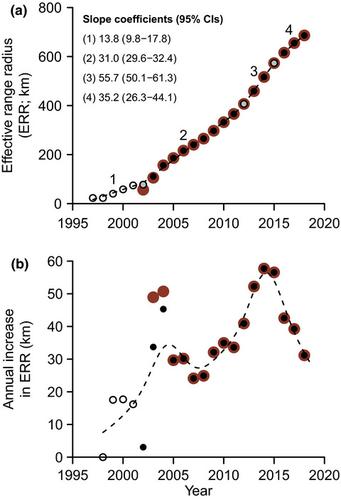当前位置:
X-MOL 学术
›
J. Appl. Ecol.
›
论文详情
Our official English website, www.x-mol.net, welcomes your
feedback! (Note: you will need to create a separate account there.)
Temporal dynamics and drivers of landscape‐level spread by emerald ash borer
Journal of Applied Ecology ( IF 5.0 ) Pub Date : 2020-04-15 , DOI: 10.1111/1365-2664.13613 Samuel F. Ward 1 , Songlin Fei 1 , Andrew M. Liebhold 2, 3
Journal of Applied Ecology ( IF 5.0 ) Pub Date : 2020-04-15 , DOI: 10.1111/1365-2664.13613 Samuel F. Ward 1 , Songlin Fei 1 , Andrew M. Liebhold 2, 3
Affiliation

|
1. Non-native insects pose threats to forest health and often spread via stratified dispersal in which long-distance jumps cause elevated rates of range expansion. Quantifying patterns and developing models of spread are central to understanding drivers of invasion and forecasting future invasions. 2. We investigated the utility of models for characterizing and predicting spread of emerald ash borer (EAB), quantified temporal dynamics of spread and identified correlates of county-level invasion risk. 3. We estimated rates and frequency of EAB spread and length of long-distance jumps throughout the contiguous USA from 1997 to 2018 and compared observed patterns with model predictions. A time-to-event model was then developed at the county level to assess the influence of habitat characteristics and propagule pressure on invasion risk. The final model was used to forecast invasion risk across the contiguous USA. 4. Range expansion by EAB accorded well with model predictions. Following the initial establishment phase, range expansion rates were biphasic, shifting to a faster, linear pattern around 2002 and then declining from 2015 onwards. From 2003 onwards, EAB invaded 6-134 new counties per year, including a mean of 14 discrete jumps per year averaging 93 ± 7 SE km. 5. Risk of spread was positively associated with proximity to previously invaded areas, human population density and densities of ash and non-ash trees in rural forests but negatively associated with temperature. 6. Synthesis and applications. At the regional level, the invasion by emerald ash borer appears to be entering the saturation phase, indicating that most high-risk counties in the eastern USA have been invaded. Even though spread has recently slowed, counties in close proximity to invaded areas and that have high densities of humans and trees are at the greatest risk of becoming invaded. Taken together, our findings provide insight into historical and future dynamics of range expansion by emerald ash borer, which can be used to guide risk assessments for potential invaders capable of frequent long-distance dispersal.
中文翻译:

翡翠灰螟在景观层面传播的时间动态和驱动因素
1. 非本地昆虫对森林健康构成威胁,通常通过分层扩散传播,其中长距离跳跃会导致范围扩大率升高。量化模式和开发传播模型对于理解入侵的驱动因素和预测未来的入侵至关重要。2. 我们研究了表征和预测翡翠灰蛀虫 (EAB) 传播的模型的效用,量化了传播的时间动态,并确定了县级入侵风险的相关性。3. 我们估计了 1997 年至 2018 年整个美国本土的 EAB 传播率和频率以及长距离跳跃的长度,并将观察到的模式与模型预测进行了比较。然后在县级开发了事件发生时间模型,以评估栖息地特征和繁殖压力对入侵风险的影响。最终模型用于预测美国本土的入侵风险。4. EAB 的范围扩展符合模型预测。在最初的建立阶段之后,范围扩展率是双相的,在 2002 年左右转变为更快的线性模式,然后从 2015 年开始下降。从 2003 年起,EAB 每年入侵 6-134 个新县,包括平均每年 14 次离散跳跃,平均 93 ± 7 SE 公里。5. 传播风险与与先前入侵地区的距离、人口密度以及农村森林中灰树和非灰树的密度呈正相关,但与温度呈负相关。6. 合成与应用。在区域层面,翡翠灰蛀虫的入侵似乎进入了饱和阶段,表明美国东部的大多数高风险县都已被入侵。尽管最近传播速度有所放缓,但靠近被入侵地区且人口和树木密度高的县最有可能被入侵。综上所述,我们的研究结果提供了对翡翠灰螟范围扩张的历史和未来动态的洞察,可用于指导能够频繁远距离传播的潜在入侵者的风险评估。
更新日期:2020-04-15
中文翻译:

翡翠灰螟在景观层面传播的时间动态和驱动因素
1. 非本地昆虫对森林健康构成威胁,通常通过分层扩散传播,其中长距离跳跃会导致范围扩大率升高。量化模式和开发传播模型对于理解入侵的驱动因素和预测未来的入侵至关重要。2. 我们研究了表征和预测翡翠灰蛀虫 (EAB) 传播的模型的效用,量化了传播的时间动态,并确定了县级入侵风险的相关性。3. 我们估计了 1997 年至 2018 年整个美国本土的 EAB 传播率和频率以及长距离跳跃的长度,并将观察到的模式与模型预测进行了比较。然后在县级开发了事件发生时间模型,以评估栖息地特征和繁殖压力对入侵风险的影响。最终模型用于预测美国本土的入侵风险。4. EAB 的范围扩展符合模型预测。在最初的建立阶段之后,范围扩展率是双相的,在 2002 年左右转变为更快的线性模式,然后从 2015 年开始下降。从 2003 年起,EAB 每年入侵 6-134 个新县,包括平均每年 14 次离散跳跃,平均 93 ± 7 SE 公里。5. 传播风险与与先前入侵地区的距离、人口密度以及农村森林中灰树和非灰树的密度呈正相关,但与温度呈负相关。6. 合成与应用。在区域层面,翡翠灰蛀虫的入侵似乎进入了饱和阶段,表明美国东部的大多数高风险县都已被入侵。尽管最近传播速度有所放缓,但靠近被入侵地区且人口和树木密度高的县最有可能被入侵。综上所述,我们的研究结果提供了对翡翠灰螟范围扩张的历史和未来动态的洞察,可用于指导能够频繁远距离传播的潜在入侵者的风险评估。











































 京公网安备 11010802027423号
京公网安备 11010802027423号